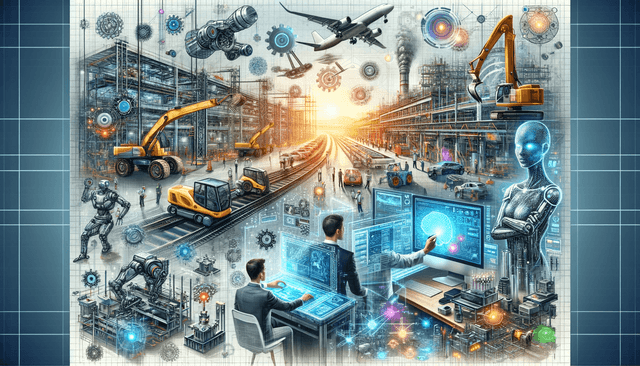Revolutionizing the Future: Engineering Applications of Artificial Intelligence

Imagine a world where the complexities of engineering are simplified by the intellect of machines, where artificial intelligence (AI) not only complements but enhances human capabilities. The engineering applications of artificial intelligence are not just a futuristic fantasy but a present reality, transforming industries and redefining the boundaries of what’s possible. As we delve into this exciting realm, we uncover how AI is revolutionizing everything from automated design to predictive maintenance, from smart manufacturing to the intricate world of robotics. This exploration is not just about understanding AI’s role in engineering but about envisioning a future crafted by the synergy of human ingenuity and machine intelligence. Ready to discover how? Let’s dive into the engineering applications of artificial intelligence and witness the unfolding of a new era.
Table of Contents
Introduction to Engineering Applications of Artificial Intelligence
The dawn of artificial intelligence has ushered in a new epoch for the engineering sector. This transformative technology is not just a tool but a game-changer, offering solutions that are reshaping the very fabric of how engineering challenges are approached and solved. But what exactly does it mean for the industry?The AI Revolution in Engineering
AI’s integration into engineering is multifaceted, involving a spectrum of technologies from machine learning to neural networks. These sophisticated tools empower engineers to push the envelope, creating more efficient, safer, and sustainable solutions.- Automated Design: AI algorithms can rapidly generate and evaluate a multitude of design variations, pinpointing optimal solutions faster than ever before.
- Predictive Analysis: Machine learning models can forecast potential system failures, allowing for proactive maintenance and reducing downtime.
- Smart Infrastructure: AI-driven systems are enabling smarter energy use, traffic management, and resource allocation in urban environments.
AI in Design and Simulation
Gone are the days of trial-and-error being the mainstay in engineering design. AI has taken center stage, offering precision and efficiency that’s nothing short of a masterpiece. Let’s break down how AI is making waves in design and simulation.Design Optimization with AI
AI is like the ultimate assistant, tirelessly working to refine designs until they hit that sweet spot of form and function. By harnessing the power of algorithms, engineers can explore a vast design space and home in on the most effective solutions.- Generative Design: AI can generate a plethora of design alternatives based on specific criteria, leading to innovative solutions that might not have crossed a human mind.
- Simulation: AI-driven simulations can predict how a design will perform under various conditions, saving time and resources in the testing phase.
Machine Learning in Predictive Maintenance
Machine learning is the crystal ball of the engineering world, giving a glimpse into the future of equipment health. Predictive maintenance is where this foresight becomes invaluable, turning potential disasters into mere hiccups.Preventing Downtime with Predictive Insights
By analyzing data trends, machine learning models can predict when a machine is likely to fail, ensuring that maintenance can be performed just in the nick of time.- Condition Monitoring: Sensors collect real-time data on equipment, which machine learning algorithms analyze to detect anomalies.
- Failure Prediction: These algorithms can estimate the remaining useful life of machinery, scheduling maintenance before a breakdown occurs.
Smart Manufacturing and Industry 4.0
Industry 4.0 is not just a buzzword; it’s the beating heart of modern manufacturing, and AI is the lifeblood that keeps it pumping. Smart manufacturing is where the magic happens, with AI ensuring the show goes on efficiently and effectively.AI-Powered Production Lines
From assembly to quality control, AI is there every step of the way, ensuring that production lines are not just smart but downright genius.- Process Optimization: AI systems continuously analyze production data to optimize processes, minimize waste, and improve product quality.
- Quality Control: Image recognition and machine learning work together to spot defects and inconsistencies, ensuring that only the best products make it to market.
Robotics and Automation
Robots and AI are a match made in engineering heaven, working hand in hand—or should we say, circuit to algorithm—to revolutionize the way tasks are performed.The Dynamic Duo: AI and Robotics
AI breathes life into robots, giving them the ability to learn, adapt, and work with a level of precision that’s simply astounding.- Autonomous Robots: Equipped with AI, these robots can navigate complex environments, making decisions on the fly and performing tasks with minimal human intervention.
- Collaborative Robots: Also known as cobots, these AI-driven machines work alongside humans, enhancing productivity and safety.
Artificial Intelligence in Civil and Environmental Engineering
AI is not just about gears and circuits; it’s also playing a pivotal role in shaping the world we live in. Civil and environmental engineering are reaping the benefits of AI’s analytical prowess, leading to smarter, more sustainable solutions.Building a Better World with AI
From the design of resilient infrastructure to the management of natural resources, AI is a powerful ally in the quest for sustainability.- Infrastructure Analysis: AI algorithms assess the condition of bridges, roads, and buildings, aiding in the maintenance and development of safer structures.
- Environmental Monitoring: Machine learning models analyze patterns in environmental data, helping to predict natural disasters and mitigate their impact.
Conclusion: The Future of AI in Engineering
The engineering applications of artificial intelligence are not just transforming the industry; they’re setting the stage for a future where innovation knows no bounds. As engineers continue to harness AI’s potential, we can expect a world where challenges are met with intelligent solutions, where efficiency and sustainability go hand in hand, and where the possibilities are as limitless as our imagination. AI is not just a tool in the engineer’s belt—it’s a companion on the journey to a smarter, better future. So let’s embrace the engineering applications of artificial intelligence and watch as they pave the way for a new era of human achievement.Ai content
This article was generated by Skelet AI
2000+ words in under 10 seconds, costing on average $0.05 per article.*
Ai content
AI-Powered Visuals
Skelet AI HD images effortlessly generated with easy prompts